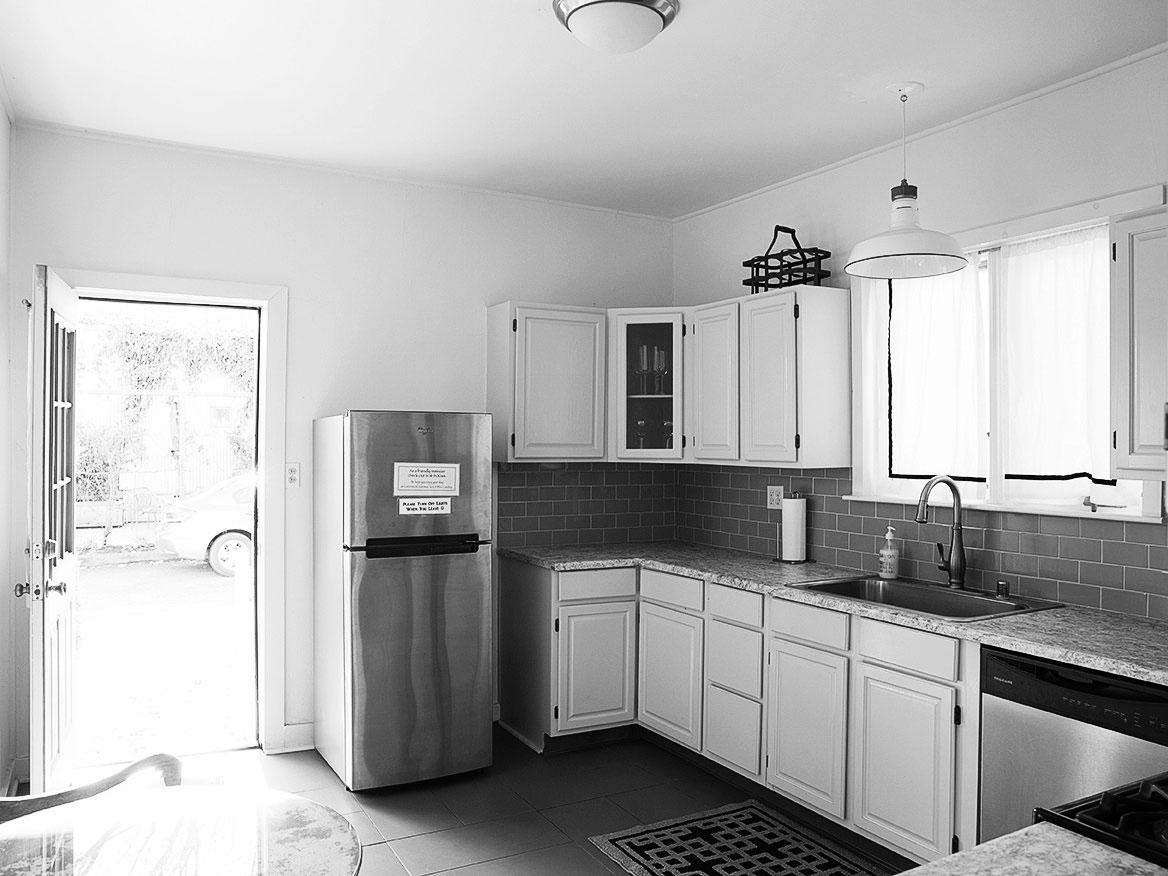
How to Design a Wine Country Cottage

1. Open up the Cabinetry
Open shelving is having a moment and with good reason. An open concept makes everyday access easier and helps guests feel more comfortable accessing what they need, too. Without cabinets hiding the cluttered contents from view, you’re forced to edit and we think that’s a good thing. And perhaps most importantly, open shelves open up the room and make a kitchen feel more spacious, which was a bonus in this small kitchen.
TIP: Don’t feel obligated to stick with monochromatic glasses and dishware. We like a mix of colors within a range. For example, we chose a neutral palette going from white to a rich, deep brown. Unleash your inner stylist by tucking in small paintings, baskets, canisters and plants.
2. Make Space for Art
Don’t think art has a place in the kitchen? Think again. This kitchen may be small but an empty wall opposite the appliances was the perfect spot to add a narrow console, a pair of stools and a gallery wall. To keep the gallery wall in scale with the console, we opted for uniform thin black frames, which feel clean and modern and help tie it all together. Food images (here they mimic colors featured on the opposite wall) are often popular choices in kitchens, but pick what you love.
TIP: When hanging a gallery wall, we recommend laying it out on the floor first and measuring the distance between each frame. Start by hanging the piece closest to the middle and working out from there.
3. Think outside the Box
Small living spaces can be tricky in a myriad of ways but they certainly make creating a cozy space easy. This living room desperately needed storage and shelving, so we had a narrow cabinet custom built.
TIP: While choosing light neutrals for furniture and decor helps create the illusion of more space, even small rooms can afford a pop of color. We went with a soothing indigo blue hue for the cabinet, which is picked up in the artwork and throw pillows, as well.
4. Opt for Double-Duty Furniture
We kept furnishings fairly minimal in this room, as comfort and functionality were key. We opted for an inviting cream-colored sofa and layered it with pillows and a throw. We then complemented the overall look with a low-profile leather sling chair that can easily move around the room.
TIP: When working in a small space, everything that takes up floor space should be multifunctional. We chose a pair of wooden cubes in place of a traditional coffee table. The cubes, which visually feel less heavy in the space, can still be used for drinks, magazines and remote controls but, more importantly, can be moved around to serve as extra seating or side tables.
5. Get Away, to Your Bedroom
We believe your bedroom should be an oasis, and the soft color palette and layers of textures in this room were chosen with that in mind. Adding throw pillows and a Moroccan blanket with pom-poms to a bed outfitted in luxurious white linen helped create a spot we would want to stay in all day.
TIP: Sconces are the perfect choice bedside, especially in a tiny space. They free up space on side tables and add an interesting design element to the room. Remember to keep them symmetrical and to think about where the light will be aimed, as they’ll also be used for ambient room lighting.
6. Focus on the Little Things
This is proof that a chair can work in even the tiniest of bedrooms. Having somewhere to sit, other than your bed, is such a nice touch, whether it’s for putting on your shoes or reading a book.
TIP: This bohemian, open-weave rattan chair is a great choice for a small corner. The shape of the chair truly envelopes you, but the openness of the weave makes it feel airy and light. We opted to throw a super soft sheepskin on top to make it extra cozy and inviting.
7. Upgrade a Classic
A Murphy bed is an obvious choice for a room short on space, but this one does double duty, as it offers storage as well.
TIP: The woven wall hanging above the bed gives the room a stylish edge, but because it can’t be damaged when the bed is closed it’s also functional in the space. We also like keeping kids’ room decor from feeling too baby-ish, as it seems crazy to spend time and money redesigning a room five years down the road. Instead, switch out the smaller decor elements periodically to match your child’s age and interests.
8. Make Every Inch Count
In a room where space is at a premium, we wanted to take advantage of every square foot. Creating a window seat gives a child a warm, sunny spot to snuggle up with a book as they grow. We had a custom cushion made for the seat, and chose fade-resistant Sunbrella fabric. And major bonus: the window seat has storage underneath.
TIP: This room also happens to get plenty of natural light. We chose white roman shades made from fade-proof Sunbrella fabric for privacy that wouldn’t diminish the nice light.
